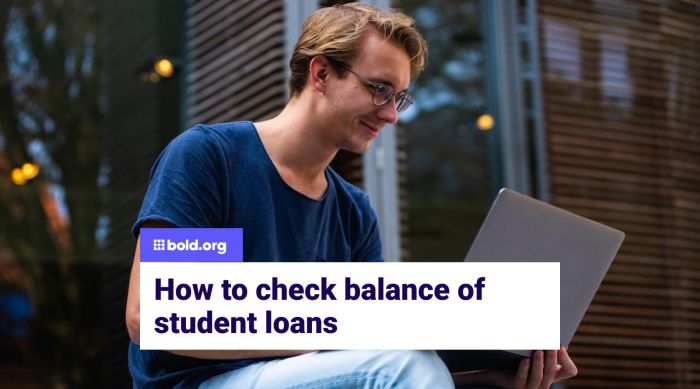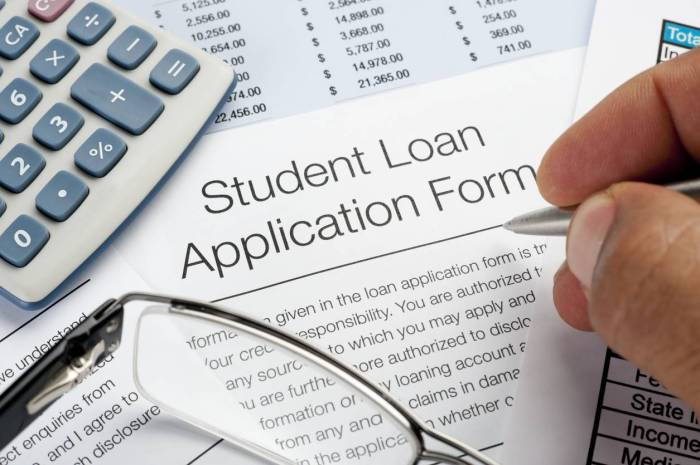
Navigating the world of student loans can feel overwhelming, especially when you need to identify your loan provider. Knowing who holds your student loan debt is crucial for managing repayments, understanding your loan terms, and accessing important resources. This guide provides a clear, step-by-step process to help you locate your student loan provider, empowering you to take control of your financial future.
From examining your loan documents and utilizing online resources like the National Student Loan Data System (NSLDS) to contacting your educational institution and reviewing bank statements, we’ll explore various methods to pinpoint your lender. We’ll also cover how to effectively contact student loan servicers and interpret crucial information found on your financial records.
Understanding Your Student Loan Details

Locating your student loan provider begins with understanding the details of your loans. This involves reviewing your loan documents and disbursement information to identify the lender and servicer. This information is crucial for managing your loans effectively and making timely payments.
Accessing your student loan documents, such as award letters and promissory notes, is the first step in identifying your lender. These documents contain vital information about your loans, including the lender’s name and contact information. Keeping these documents organized is highly recommended.
Accessing Student Loan Documents
Your award letters and promissory notes can be accessed through several methods. The most common method is checking your email inbox, especially the address you used when applying for your loans. Many institutions also send physical copies via mail. Finally, if you applied for your loans through an online portal, such as the National Student Loan Data System (NSLDS) or a private lender’s website, you may be able to access your documents digitally through that platform. Check the communications you received during the loan application process for login information or instructions.
Information Found on Loan Documents
Key pieces of information that help identify your lender are typically included on your award letters and promissory notes. These include the lender’s name (e.g., Sallie Mae, Nelnet, the U.S. Department of Education), loan type (federal or private), loan amount, interest rate, and repayment terms. The lender’s contact information, including their address, phone number, and website address, is also usually provided. Carefully examine these details to determine your loan provider.
Loan Disbursement Information
Information regarding your loan disbursement—how and when you received your loan funds—is usually communicated through various channels. Many institutions send email confirmations of disbursement, providing details of the amount transferred and the date. Some also send physical letters confirming the disbursement. Finally, online student loan portals often provide a detailed history of all disbursements, allowing you to track the funds and identify the lender through the transaction details.
Common Student Loan Servicers
Understanding the difference between a lender and a servicer is important. The lender provides the loan, while the servicer manages the loan after it’s disbursed. The following table compares some common student loan servicers and the types of loans they often manage:
| Servicer Name | Loan Type | Federal Program(s) Serviced | Private Loan Programs (Examples) |
|---|---|---|---|
| Nelnet | Federal and Private | Direct Subsidized and Unsubsidized Loans, FFEL Program Loans (Historically) | Various private lender programs |
| Navient | Federal and Private | Direct Subsidized and Unsubsidized Loans, FFEL Program Loans (Historically) | Various private lender programs |
| Great Lakes | Federal and Private | Direct Subsidized and Unsubsidized Loans, FFEL Program Loans (Historically) | Various private lender programs |
| Sallie Mae | Primarily Private | (Limited Federal Servicing in the Past) | Various Sallie Mae private loan programs |
Utilizing Online Resources

Finding your student loan provider can be easily accomplished using several reliable online resources. These resources provide a centralized location to access your loan information, eliminating the need to contact multiple lenders individually. The following sections detail how to effectively utilize these online tools.
Several government websites offer access to your student loan information. These websites are secure and designed to protect your personal data. Using these platforms ensures you are accessing accurate and up-to-date details about your loans.
Reliable Government Websites for Student Loan Information
Accessing your student loan information directly through the government is often the most reliable method. Below are some key websites:
- Federal Student Aid (FSA): This website, managed by the U.S. Department of Education, is the primary source for information on federal student loans. It provides access to your loan details, repayment options, and contact information for your loan servicer.
- National Student Loan Data System (NSLDS): NSLDS is a central database containing information about federal student loans. It’s a crucial tool for locating your loan servicer and reviewing your loan details.
Using the National Student Loan Data System (NSLDS)
The NSLDS is a powerful tool for finding your loan provider. It consolidates information from various federal student loan programs, allowing you to access a comprehensive view of your loans in one place. By using NSLDS, you can quickly identify the servicer responsible for managing your specific loans.
Creating an NSLDS Account and Accessing Loan Details
Accessing your loan information through NSLDS requires creating an account. The process is straightforward and involves providing some basic personal information to verify your identity. Once logged in, you’ll have access to a detailed summary of your federal student loans, including the name and contact information of your loan servicer(s).
- Visit the NSLDS website (the exact URL may change, so a web search for “National Student Loan Data System” is recommended).
- Click on the option to create a new account. You will typically need your Social Security number and date of birth.
- Follow the on-screen instructions to complete the registration process. This might include answering security questions and creating a password.
- Once logged in, navigate to the section displaying your loan details. This usually involves selecting a specific loan year or loan program.
- Locate the information for each loan, including the name of the loan servicer. This information is typically clearly displayed.
Flowchart: Locating Your Student Loan Provider Online
The following flowchart visually represents the steps involved in using online resources to find your student loan provider:
[Start] –> [Go to FSA or NSLDS website] –> [Create Account (if needed)] –> [Log in with credentials] –> [Navigate to Loan Details section] –> [Locate Loan Servicer Information] –> [End]
This flowchart simplifies the process. Remember that some steps, such as account creation, might require additional sub-steps. However, the overall process remains relatively straightforward and efficient.
Contacting Your Educational Institution
Your college or university’s financial aid office possesses a wealth of information regarding your student loan history, including the name of your lender. They are often the first point of contact for resolving loan-related inquiries, even after you’ve graduated. Accessing this resource can significantly streamline the process of locating your loan provider.
Your institution’s financial aid office maintains records of all financial aid disbursed to students, including student loans. This information typically includes the lender’s name and contact details. By contacting them, you can efficiently retrieve this crucial information and avoid the potential frustration of searching multiple databases.
Contacting the Financial Aid Office: Effective Communication Strategies
Effectively communicating with the financial aid office increases the likelihood of a swift and successful resolution to your query. Providing clear and concise information upfront will expedite the process.
- Prepare your student identification number (SID) or other relevant identifying information before calling. This allows the office staff to quickly access your file.
- Clearly state your purpose for calling. For instance, you can say, “I am calling to find out the name of the lender for my student loans.”
- Provide the academic years for which you received loans. This will help them narrow their search and avoid confusion with other financial aid received.
- Ask about any specific loan programs you participated in, such as federal Stafford loans or private loans from a specific lender. This added detail will further refine the search process.
- Politely inquire about the process for obtaining documentation of your loan details. They may be able to provide you with a copy of your loan disbursement records, including the lender information.
Typical Response Time from Financial Aid Offices
Response times from university financial aid offices can vary depending on factors such as the institution’s size, staffing levels, and the time of year. During peak periods, such as the beginning and end of academic semesters, response times may be longer. While some offices might provide immediate answers via phone, others may require a few business days to process your request and provide a detailed response via email. In some cases, you may need to schedule an appointment for a more in-depth consultation. Expect a response within one to two weeks as a reasonable timeframe; however, if you haven’t received a response after two weeks, it’s advisable to follow up with a phone call or email.
Steps to Follow When Contacting Your Institution
Before contacting your institution, gather necessary information like your student ID number and the years you received loans. This will make the process smoother.
- Locate your institution’s financial aid office contact information (phone number, email address, and physical address) on their website.
- Contact the office via phone or email, clearly stating your need to identify your student loan provider.
- Provide your student ID number and relevant academic years for which you received loans.
- Politely request the name of your lender and any other relevant loan information.
- Note down the information provided, and follow up if necessary.
Examining Your Bank Statements and Credit Reports
Locating your student loan provider can sometimes require examining your financial records. Your bank statements and credit reports often contain valuable clues about your loan details, including the lender’s name. By carefully reviewing these documents, you can often pinpoint the necessary information to contact your loan servicer directly.
Bank statements and credit reports offer different, yet complementary, perspectives on your student loan debt. Bank statements show the actual payment transactions, revealing the name of the recipient (your loan servicer) and the payment amount. Credit reports, on the other hand, provide a comprehensive overview of your outstanding loans, including the lender’s name, loan amount, and interest rate. Combining information from both sources strengthens your ability to identify your loan provider.
Identifying Student Loan Payments on Bank Statements
Bank statements typically list transactions chronologically. Look for recurring payments labeled with descriptive names like “Student Loan Payment,” followed by the name of the loan servicer (e.g., “Sallie Mae,” “Navient,” “Nelnet”). The amount of the payment, the date of the transaction, and the account number associated with the loan may also be included. For example, a statement might show a debit of $250.00 on October 26th to “FedLoan Servicing,” clearly indicating a student loan payment. If the description is unclear, the associated account number might help you match it with your loan documents.
Interpreting Credit Report Information
Your credit report provides a consolidated view of your debts. The “accounts” section lists all your loans, including student loans. Each entry typically shows the lender’s name (your student loan provider), the account number, the loan amount, the interest rate, and your payment history. For instance, a credit report entry might list “Discover Student Loans” as the creditor, with a current balance, credit limit (if applicable), and payment details. Carefully examining this information will help you identify all your student loan providers and their relevant contact information.
Visual Representation of Key Information
Let’s imagine a simplified bank statement excerpt. The relevant line would display: “10/26/2024 -250.00 Student Loan Payment Nelnet Acct# 1234567890.” This clearly shows the date, the payment amount (negative indicating a debit), the description, the lender’s name (Nelnet), and the account number.
Now consider a simplified credit report excerpt. The section detailing a student loan might look like this: “Creditor: Sallie Mae; Account Number: 9876543210; Credit Limit: $10,000; Current Balance: $8,000; Interest Rate: 6.5%; Payment Status: Current.” This provides the lender’s name, account number, initial loan amount, current balance, interest rate, and payment status. By comparing this information to your bank statements, you can confirm the details and ensure you are identifying the correct lender.
Contacting Student Loan Servicers Directly
Contacting your student loan servicer directly is often the most efficient way to obtain specific information about your loans, make payments, or address any concerns. This direct approach allows you to speak with a representative who can access your account details and provide personalized assistance. However, it’s crucial to be prepared with necessary information before contacting them.
It’s important to understand that your student loan servicer may change over time. Federal student loans, for instance, are often transferred between servicers, so it’s always best to verify the current servicer for each of your loans.
Common Student Loan Servicers and Contact Information
Several major companies manage federal student loans. While the specific contact information may vary, most servicers offer a range of contact methods. It’s advisable to always check the official website of your specific servicer for the most up-to-date contact details. Examples of common servicers include Nelnet, Navient, Great Lakes, FedLoan Servicing (now part of Aidvantage), and MOHELA. Finding their contact information is easily done through a simple web search for “[Servicer Name] contact information”. Each servicer will list phone numbers, mailing addresses, and links to their online portals.
Methods of Contacting Student Loan Servicers
Student loan servicers typically provide multiple avenues for contact. These include telephone support, postal mail, and secure online portals. Phone support offers immediate interaction with a representative, but wait times can vary. Mail provides a documented record of your communication but can be slower. Online portals often offer the quickest and most convenient way to access account information and perform tasks like making payments or requesting information.
Preparing Information Before Contacting Your Servicer
Before contacting your servicer, gather your student loan information. This includes your loan ID numbers, Social Security number, and the names of your educational institutions. Having this information readily available will expedite the process and ensure a smoother interaction. If you are inquiring about a specific issue, such as a payment discrepancy, have details about the transaction readily available, including dates and amounts.
Comparing Contact Methods: Efficiency and Ease of Use
Each contact method offers a unique balance of efficiency and ease of use. Phone calls provide immediate answers but can involve longer wait times. Mail offers a formal record but is the slowest method. Online portals typically offer the most convenient and efficient way to access information and manage your account, although technical issues or website complexity might occasionally present challenges. The best method depends on individual preference and the urgency of the matter. For simple inquiries or routine tasks, the online portal is generally preferred. For complex issues or those requiring immediate attention, a phone call may be more suitable.
Final Conclusion

Successfully identifying your student loan provider is the first step toward responsible loan management. By utilizing the strategies Artikeld in this guide—from reviewing your loan documents and online resources to contacting relevant institutions—you can confidently navigate the process and gain clarity on your financial obligations. Remember, proactive engagement ensures you remain informed and in control of your student loan journey.
Question Bank
What if I can’t find my loan documents?
Contact your educational institution’s financial aid office. They may have electronic records of your loan information.
What if my loan servicer’s contact information is outdated?
Check the NSLDS or your loan documents for updated contact details. If still unsuccessful, contact your educational institution.
What if I have multiple student loans from different providers?
You’ll need to identify each provider individually using the methods described in this guide. Keep detailed records of each loan’s servicer.
What should I do if I suspect my loan information is inaccurate?
Contact your loan servicer immediately to report the discrepancy and request a correction. You may also wish to review your credit report for any errors.
